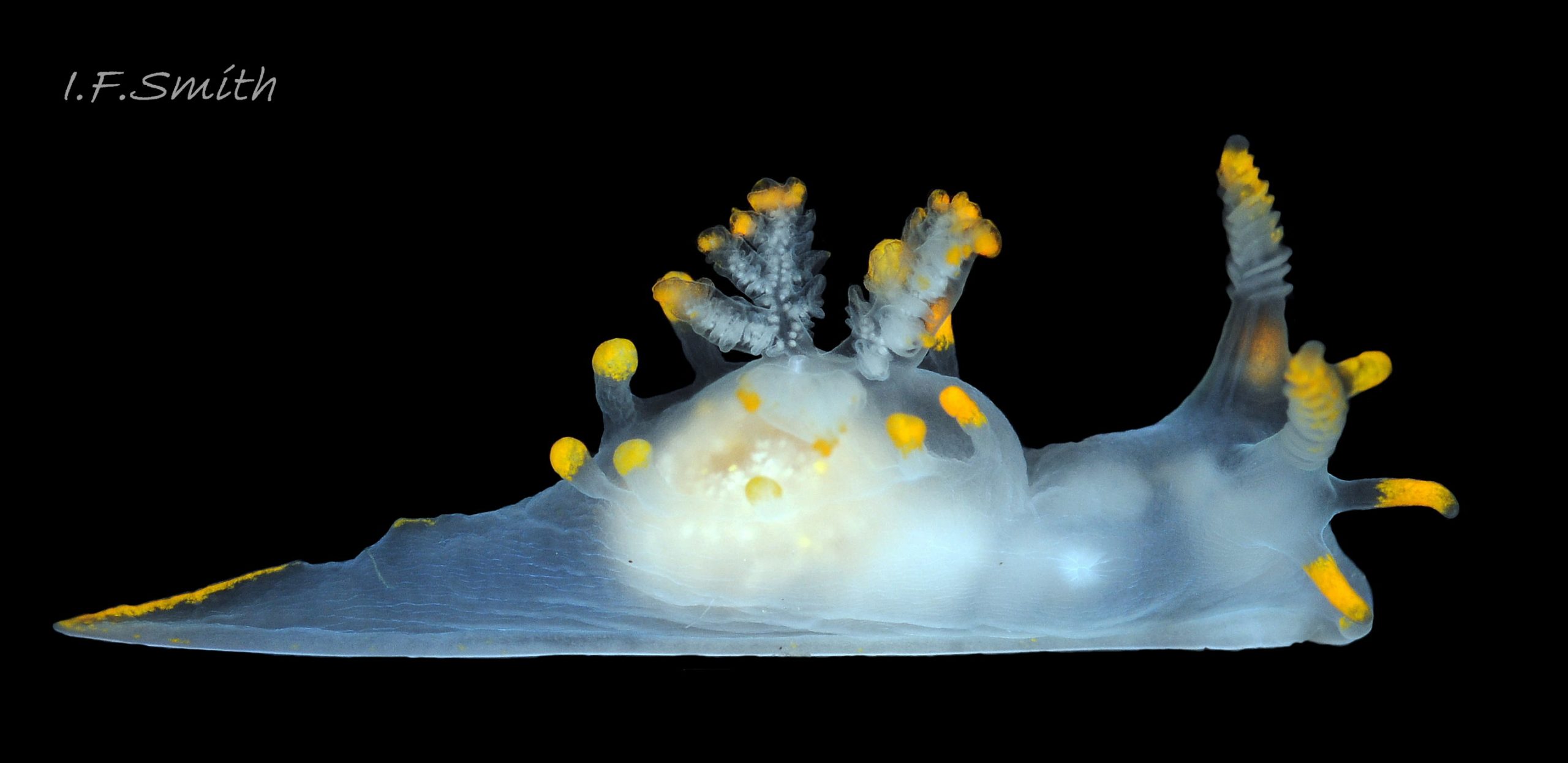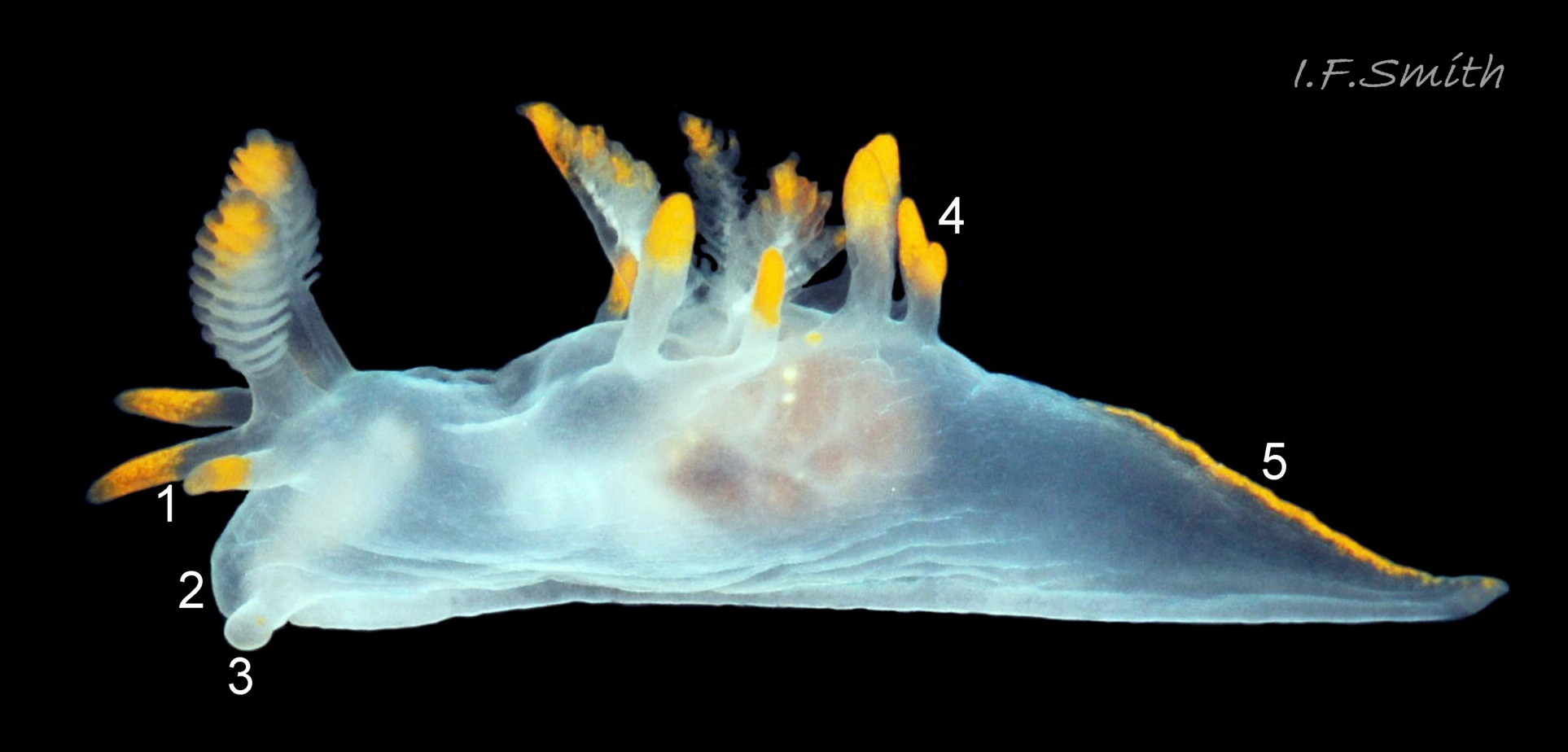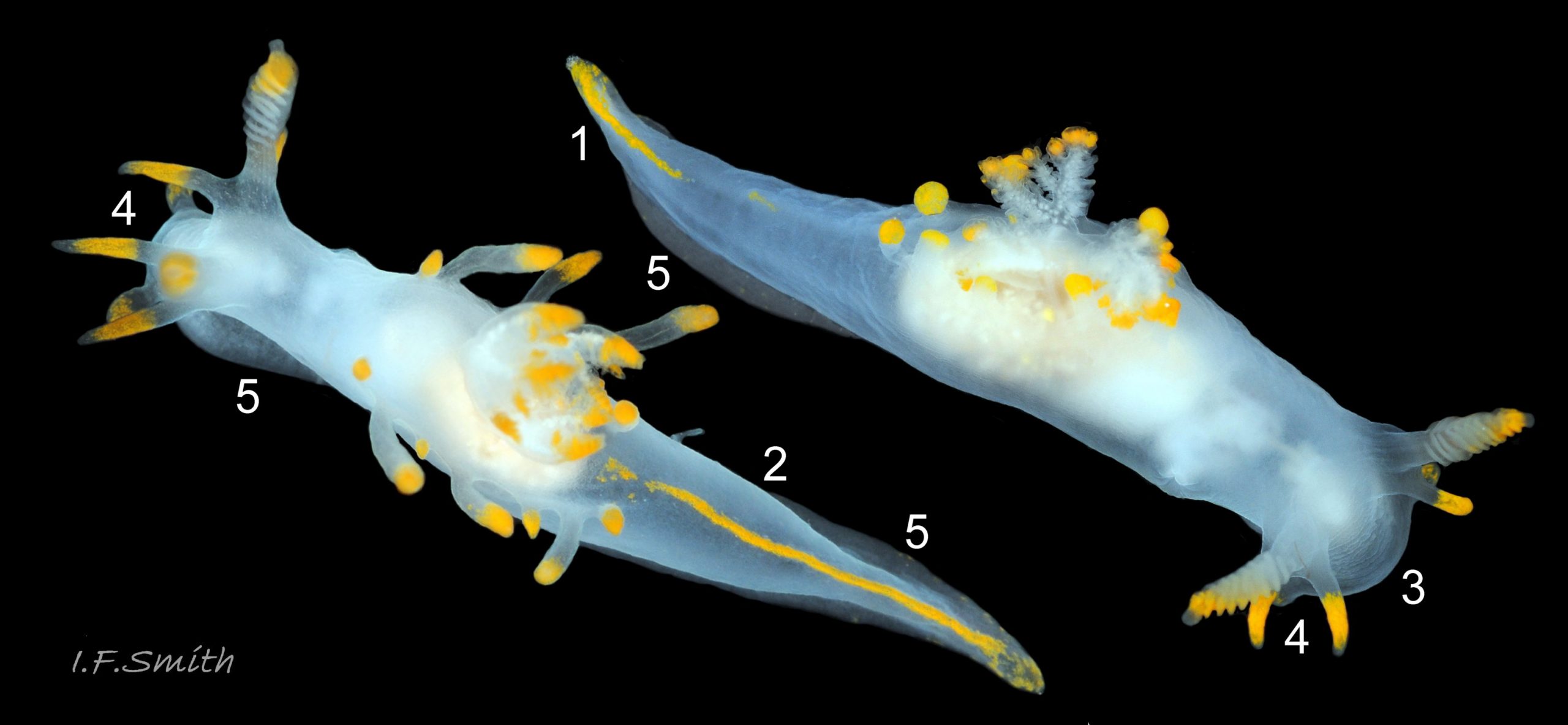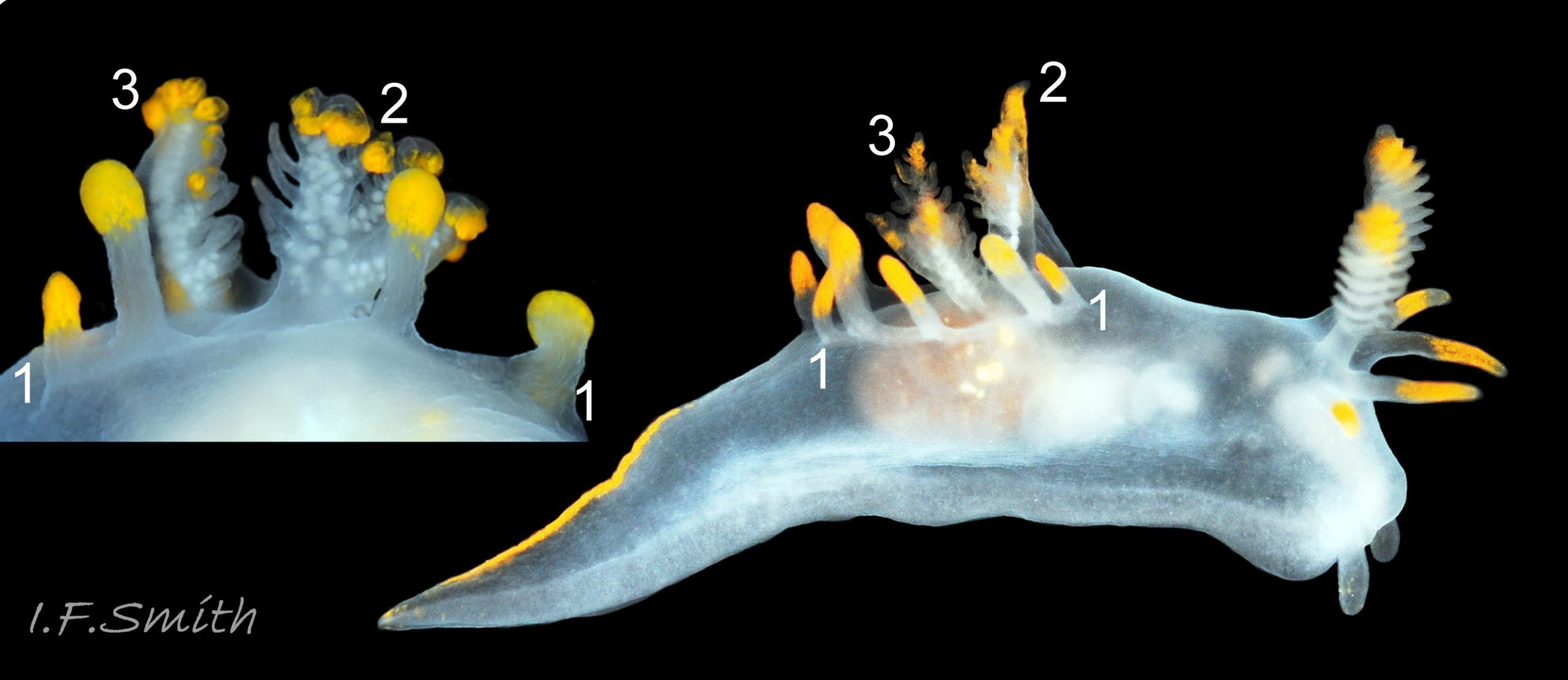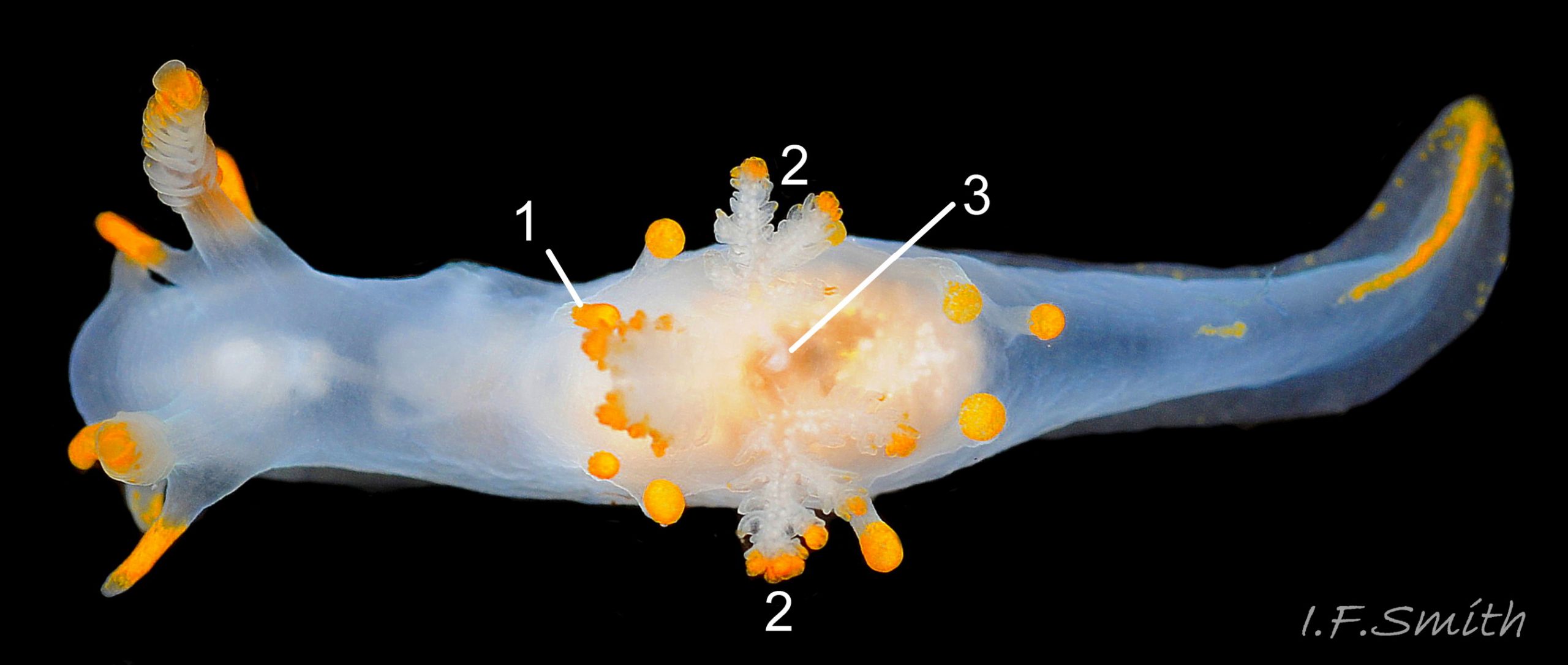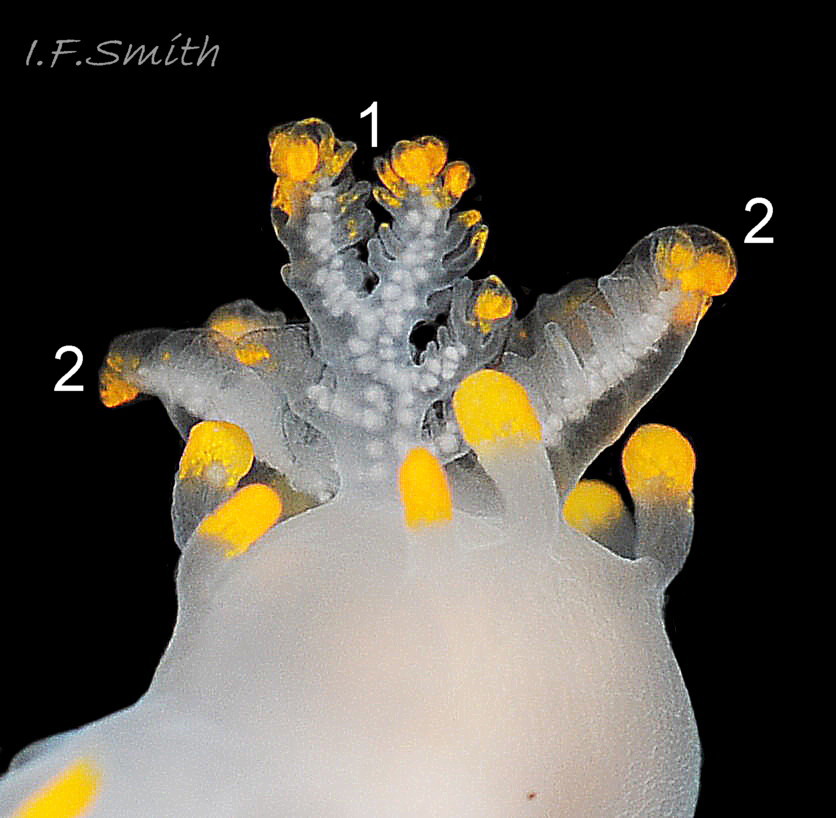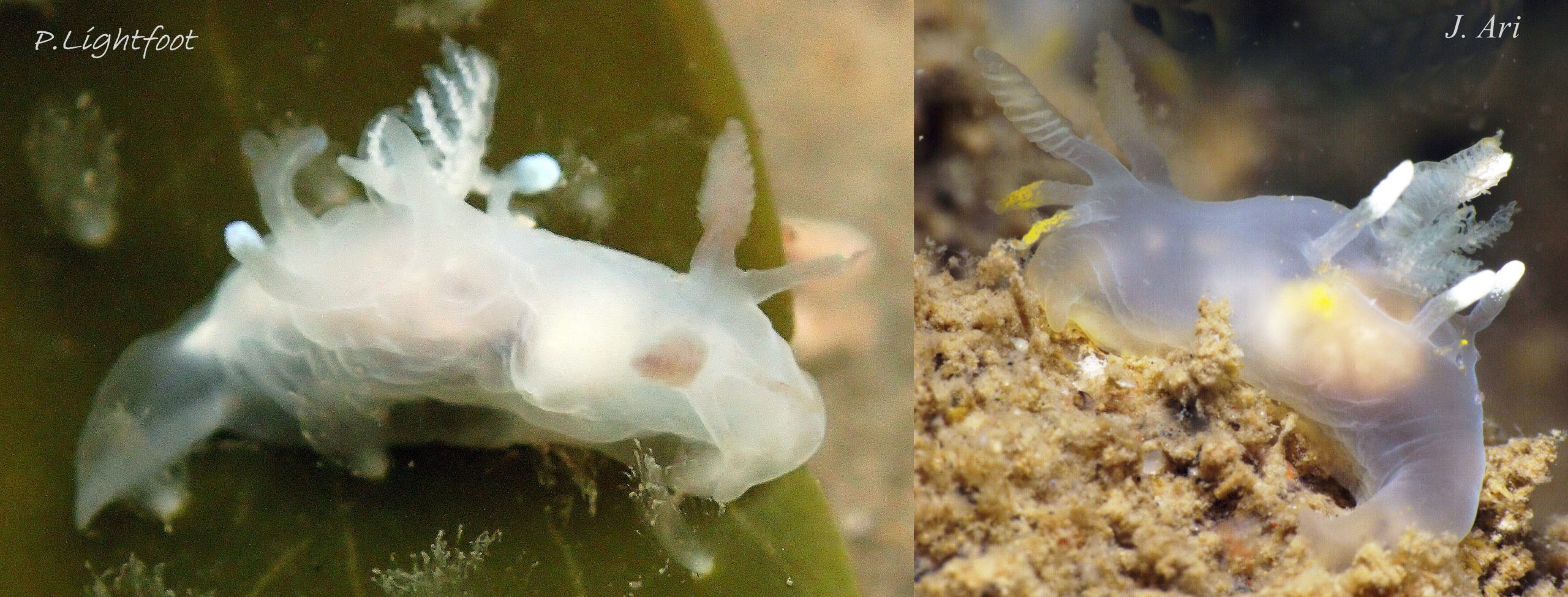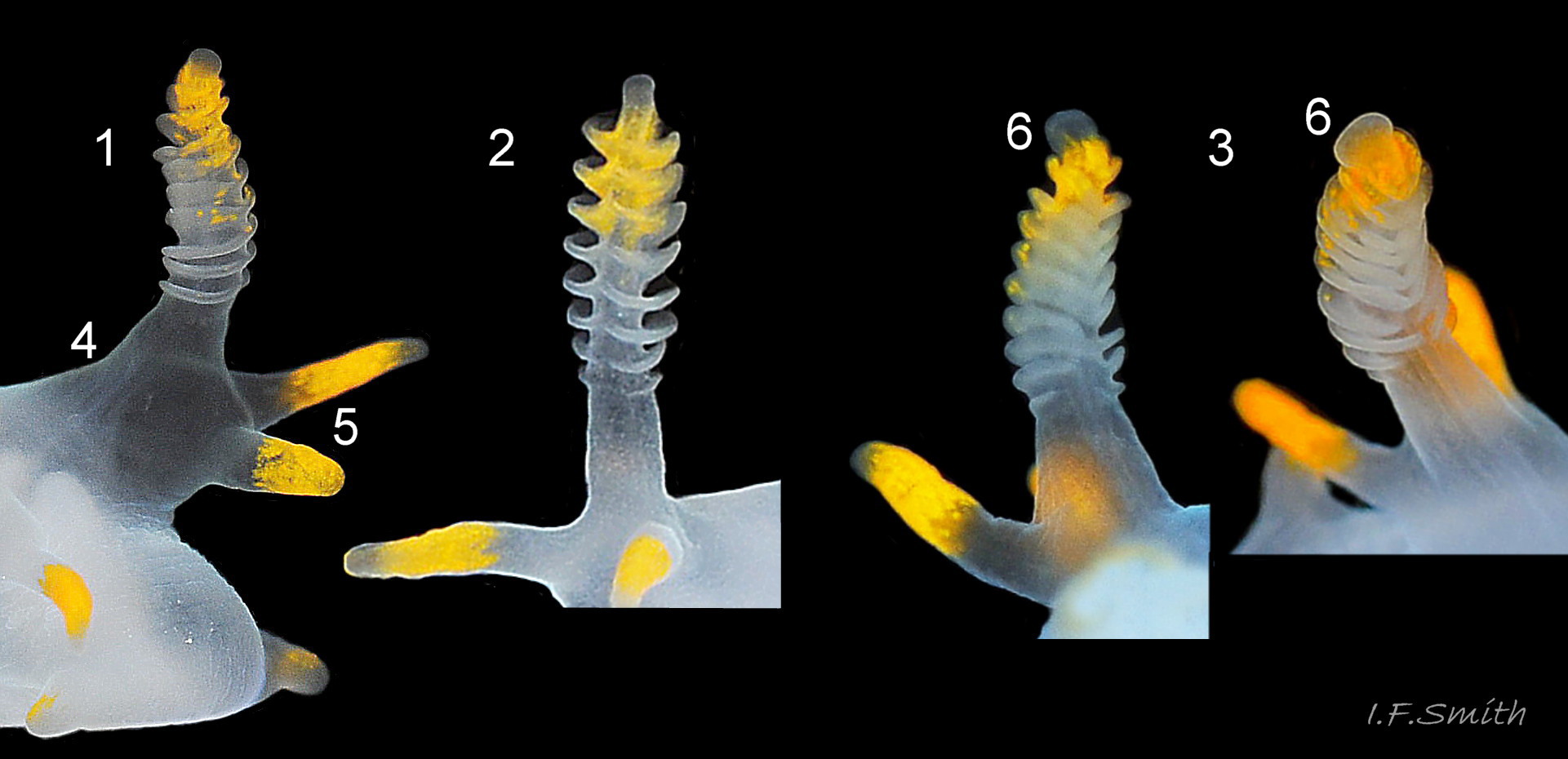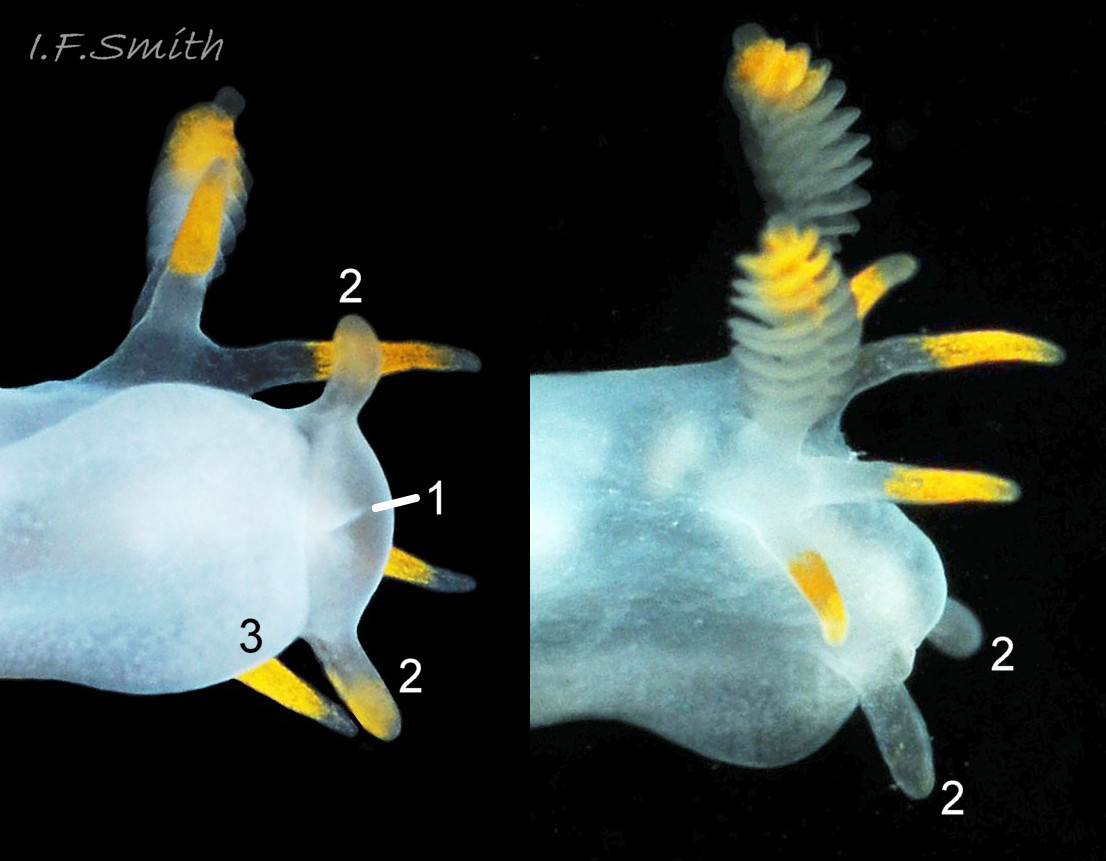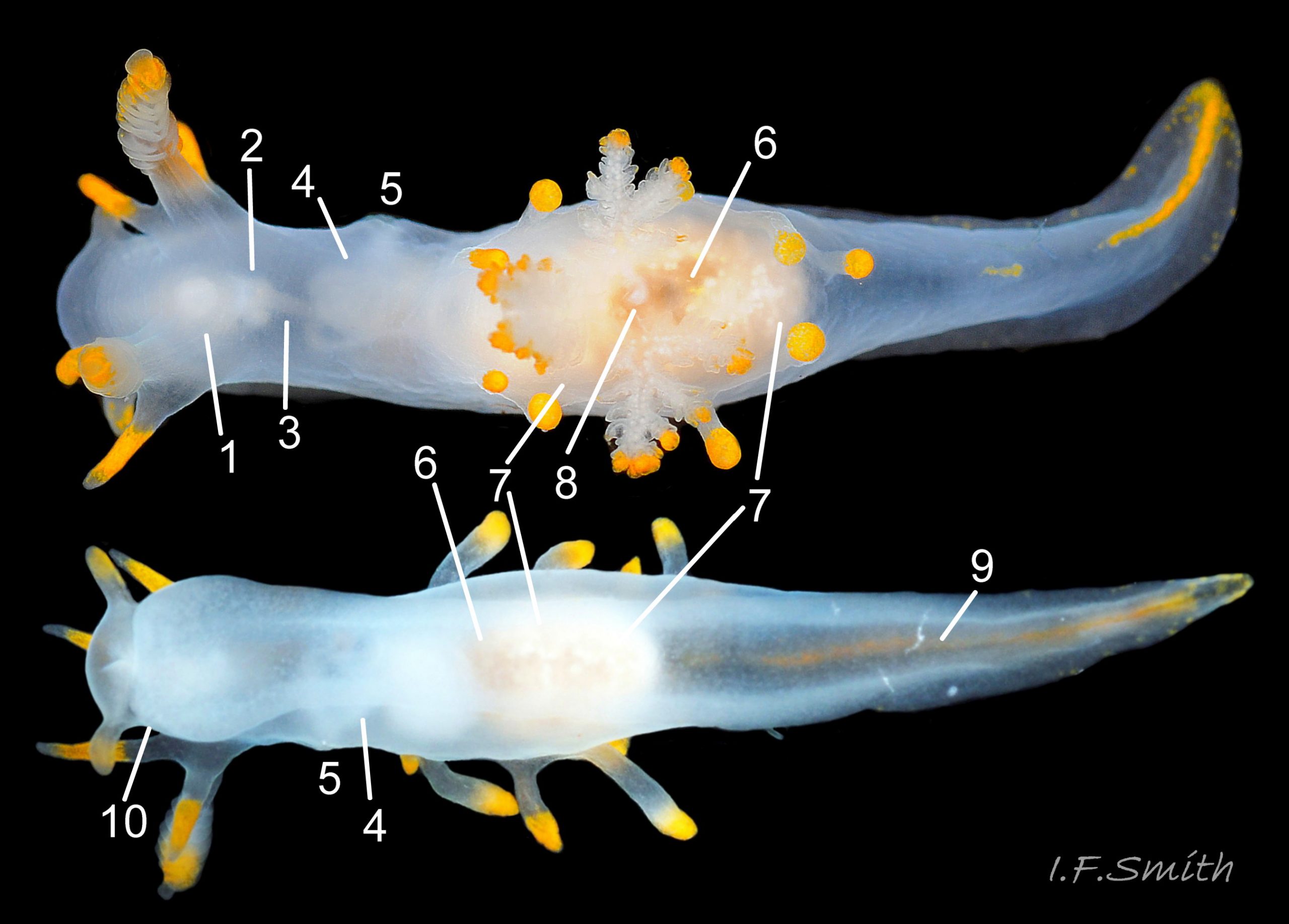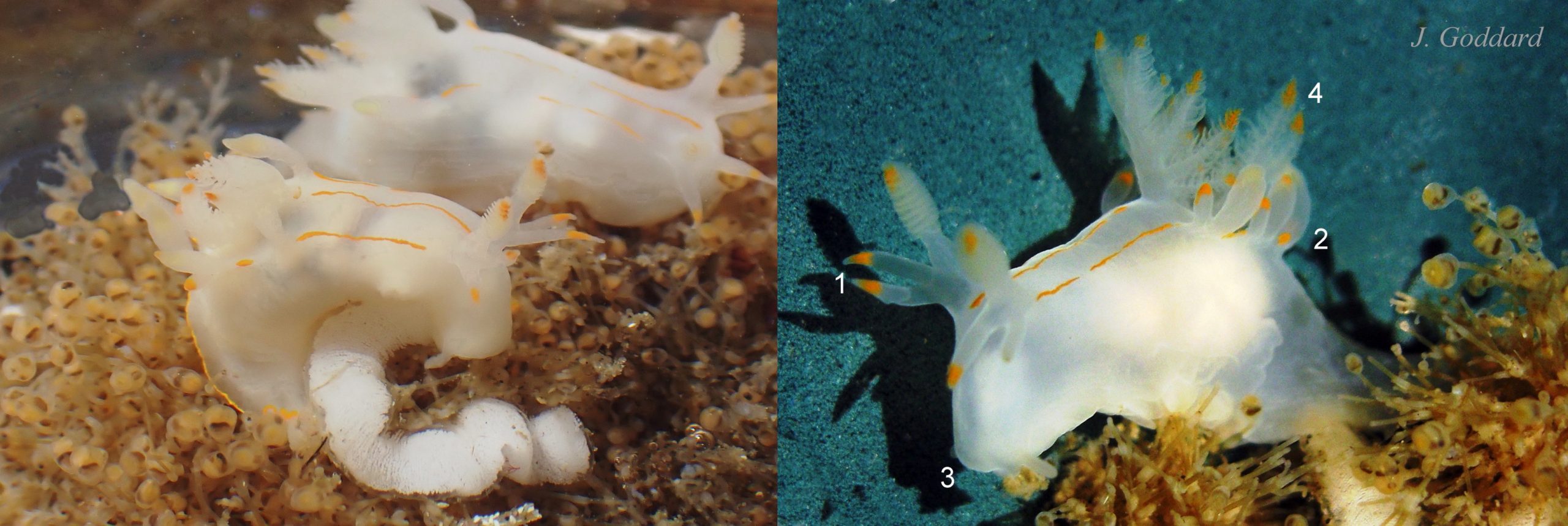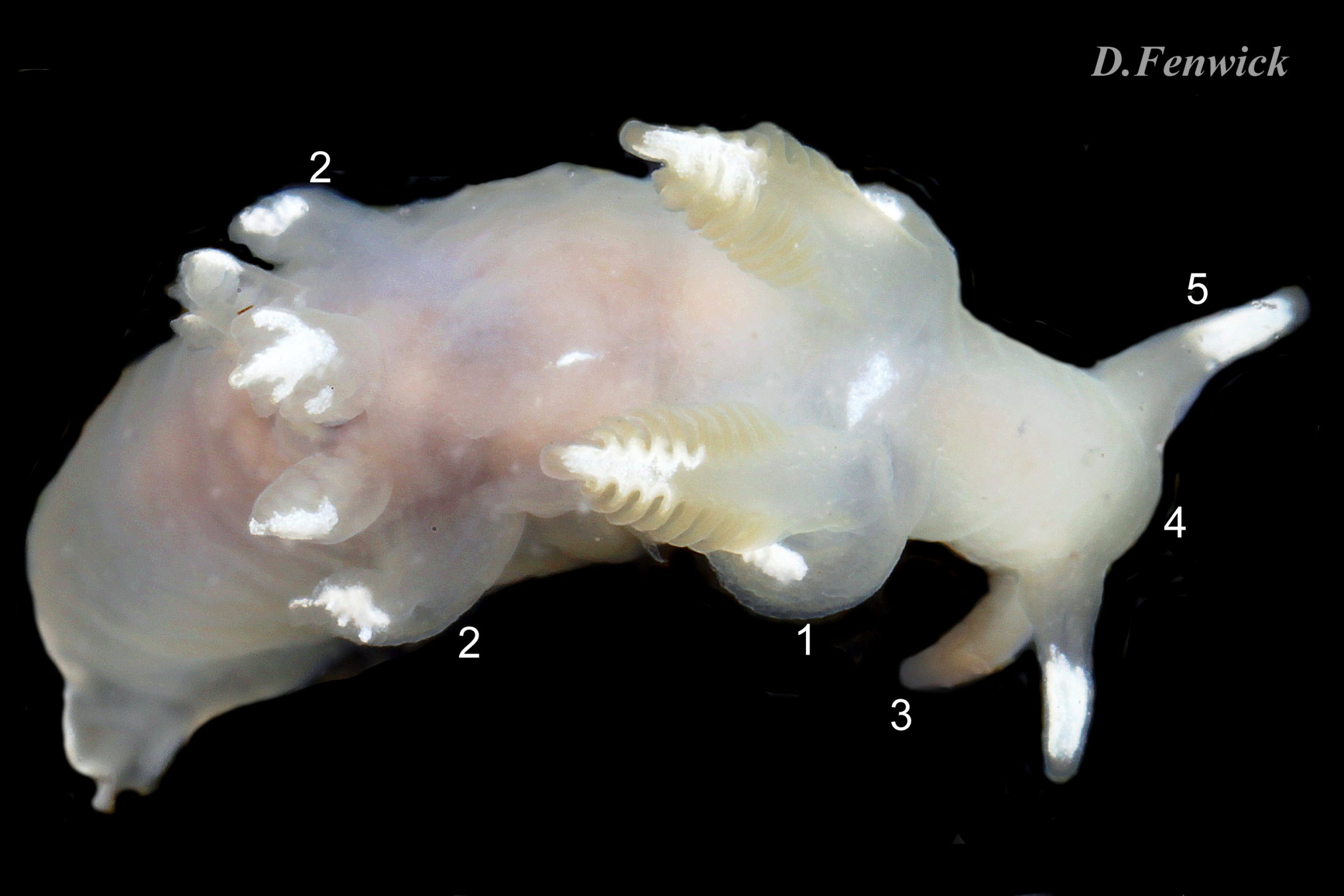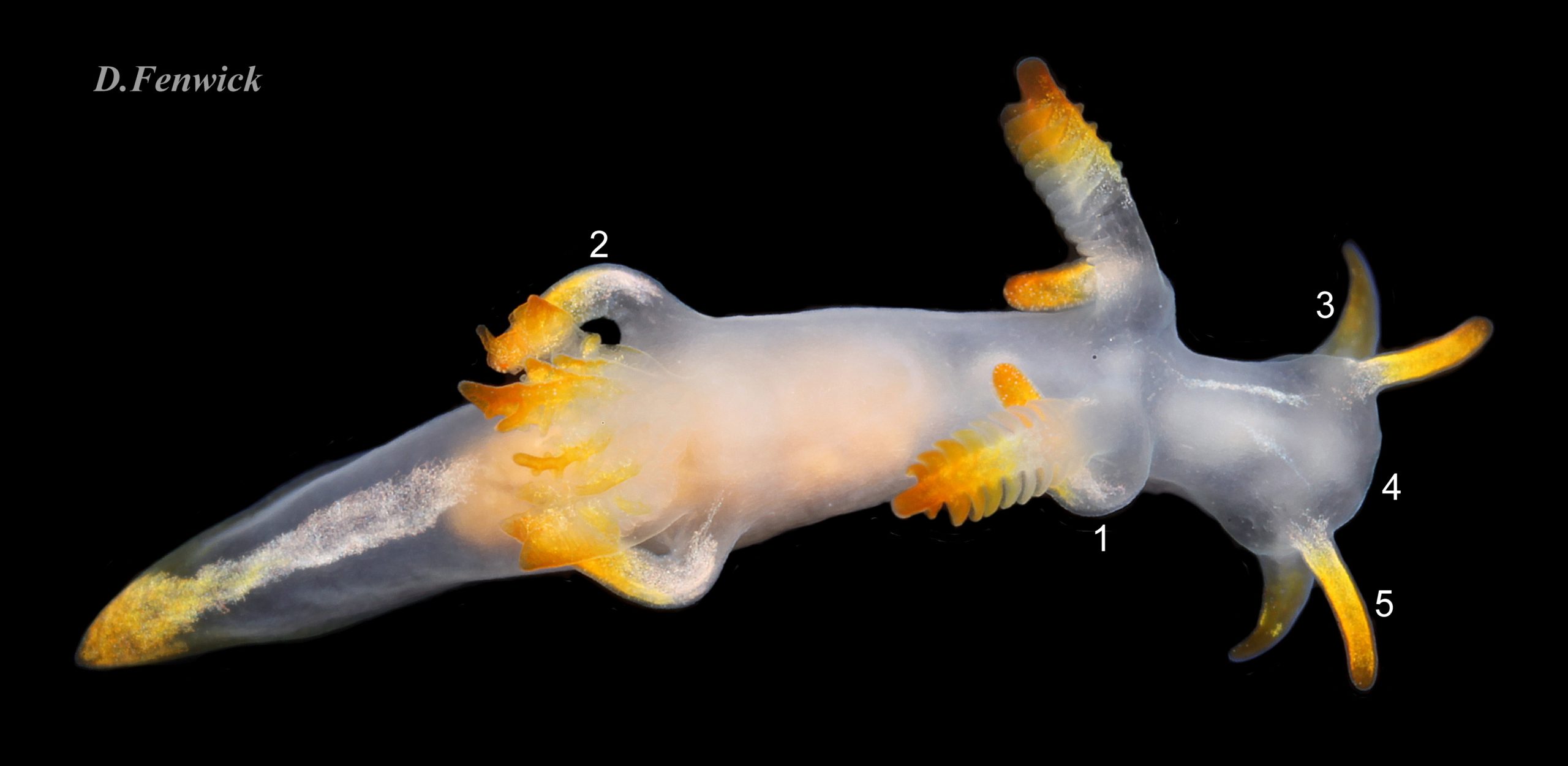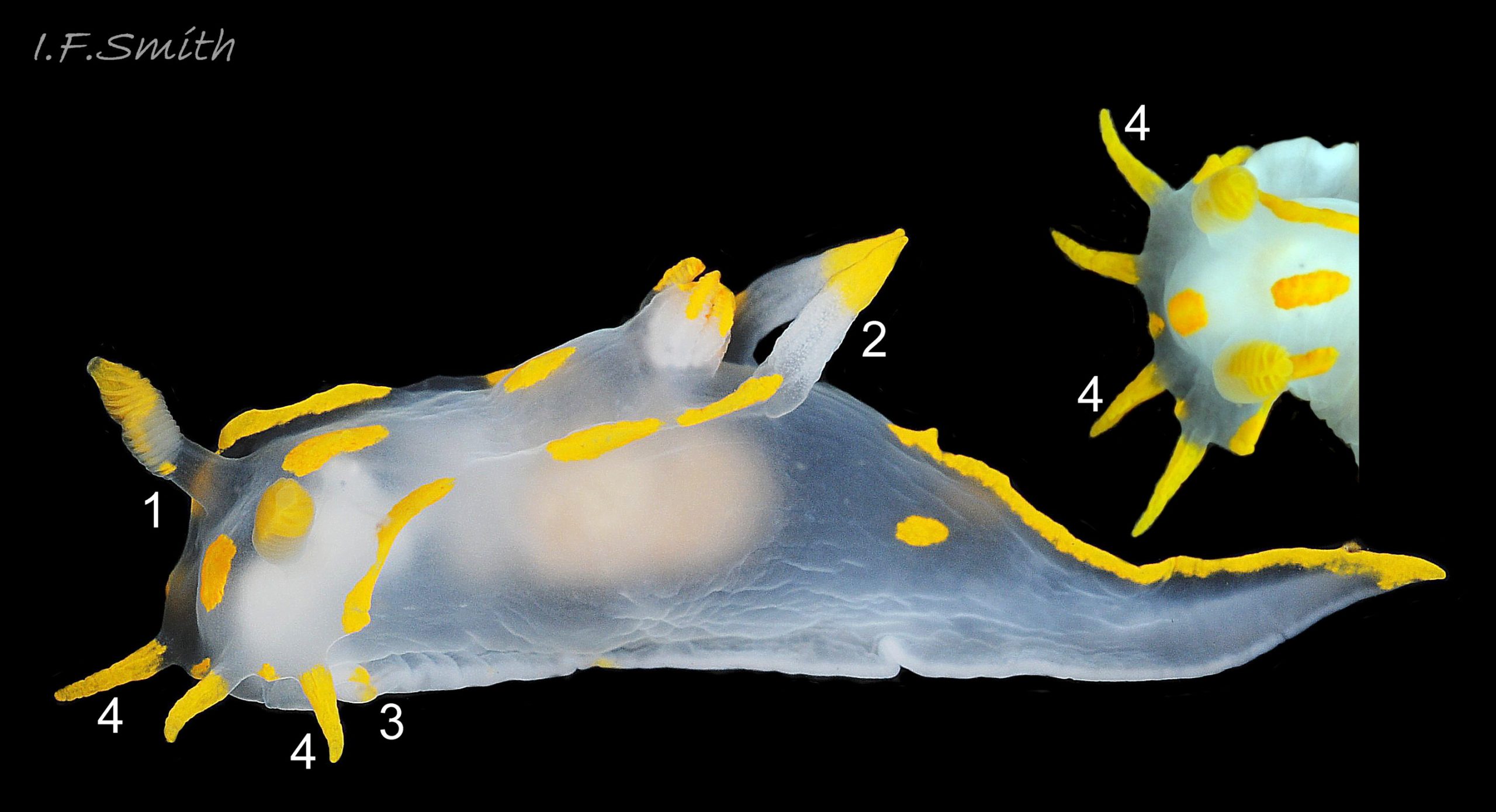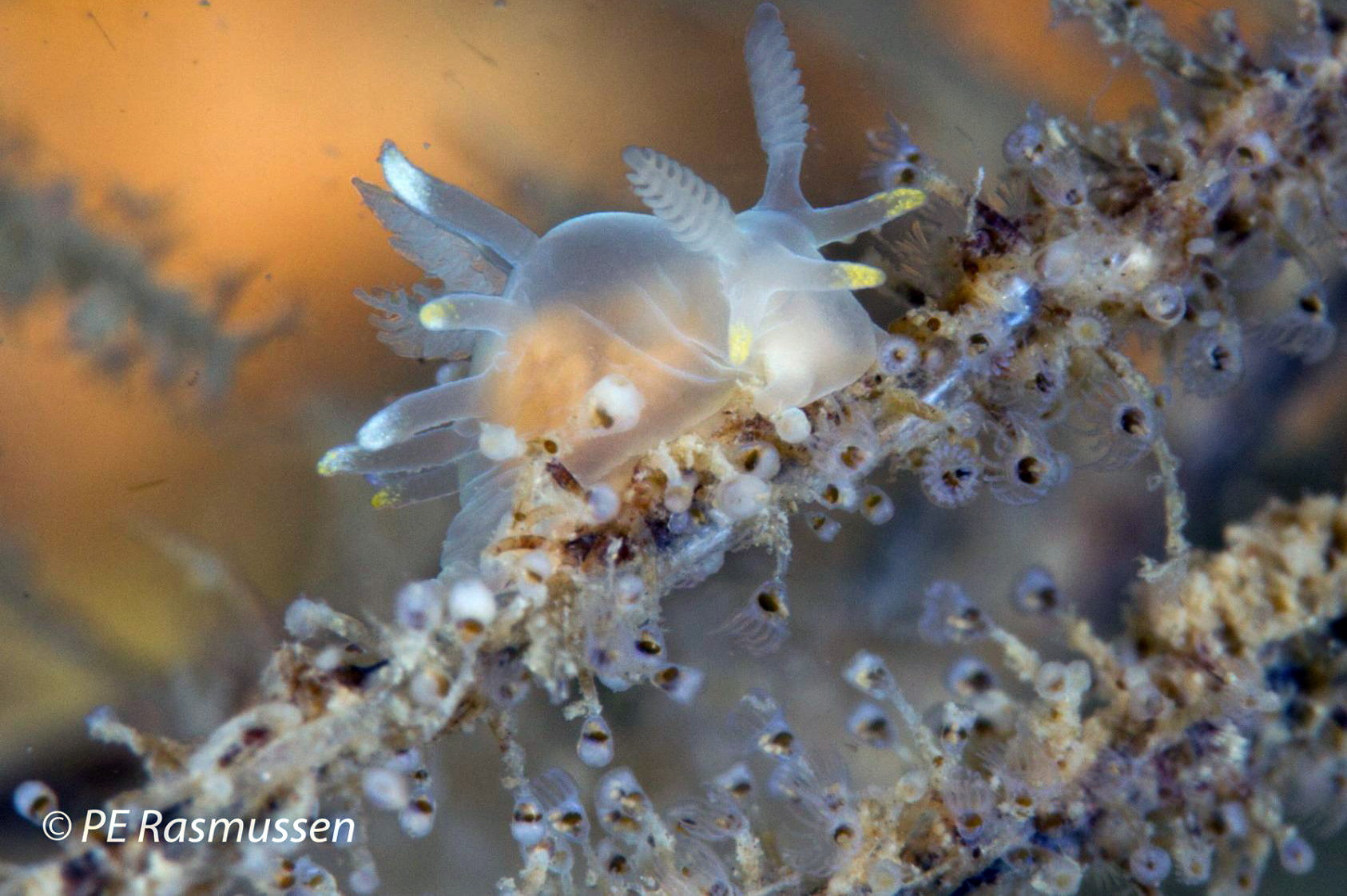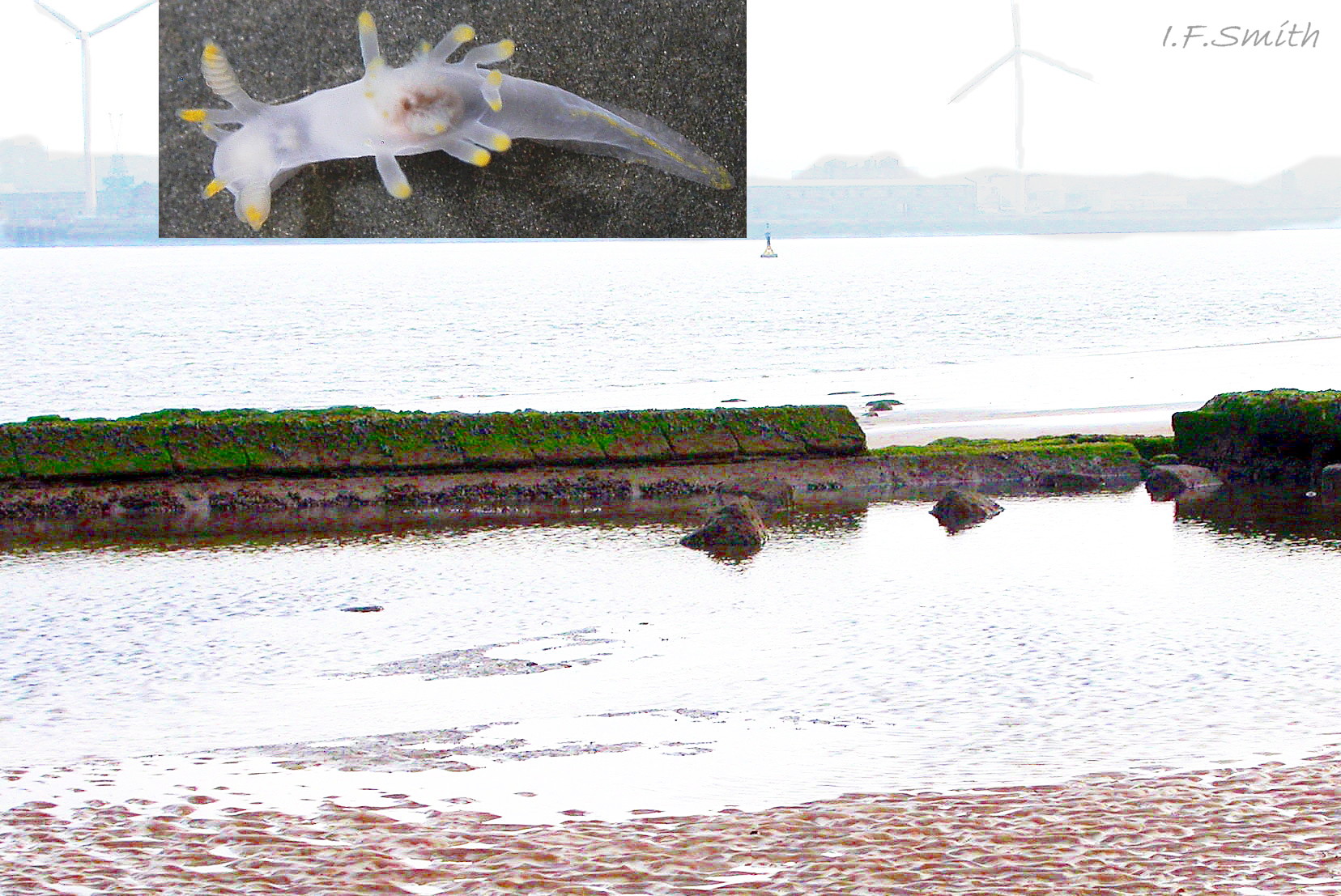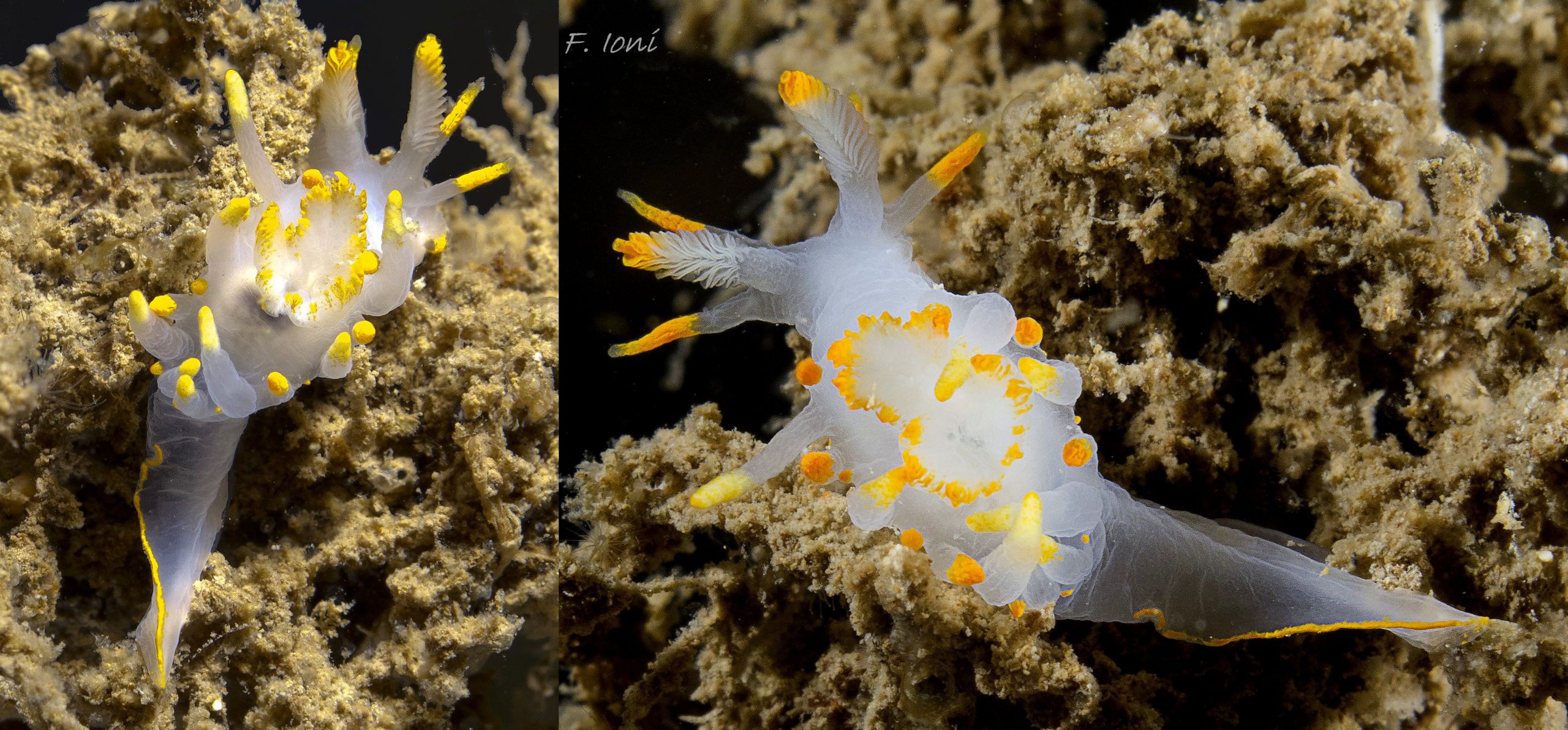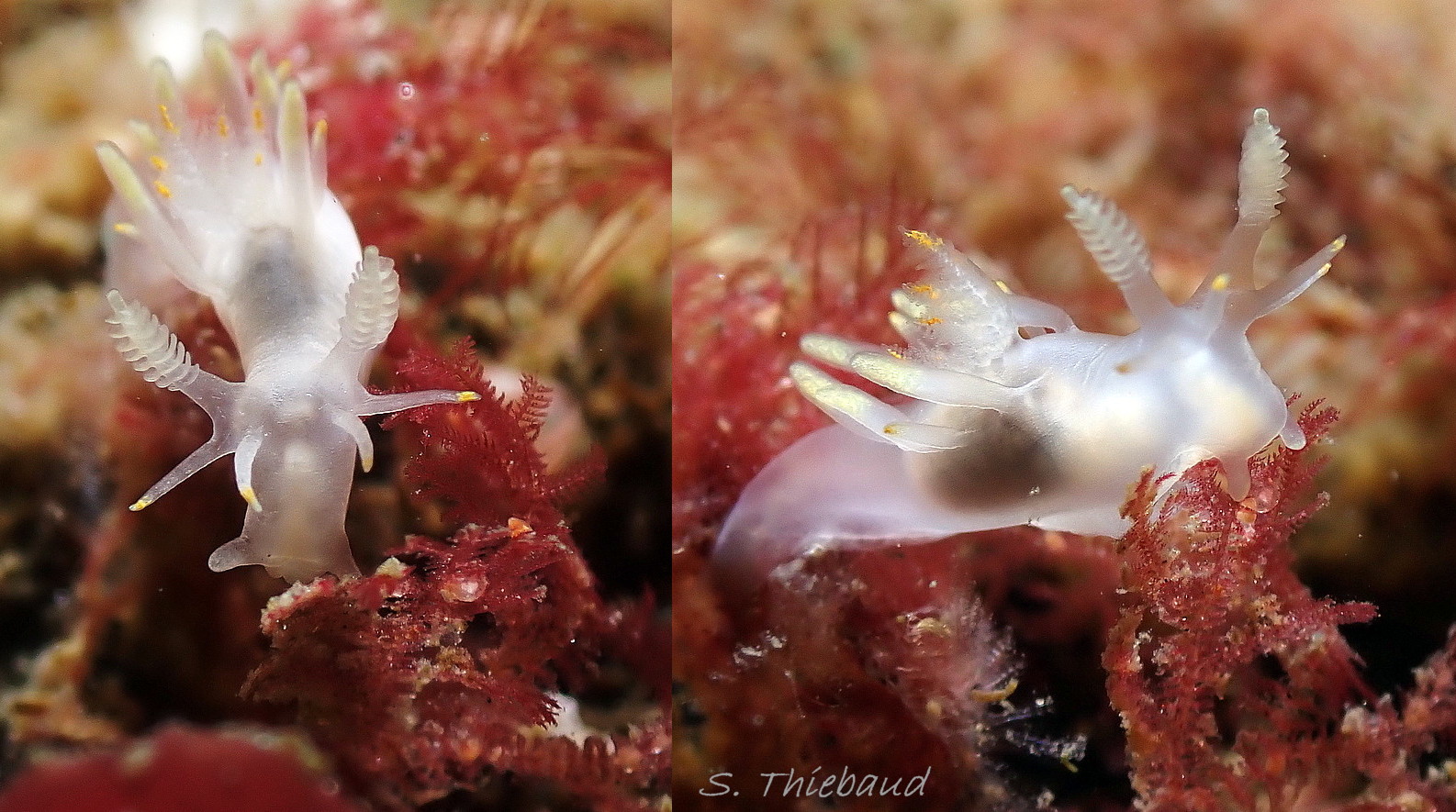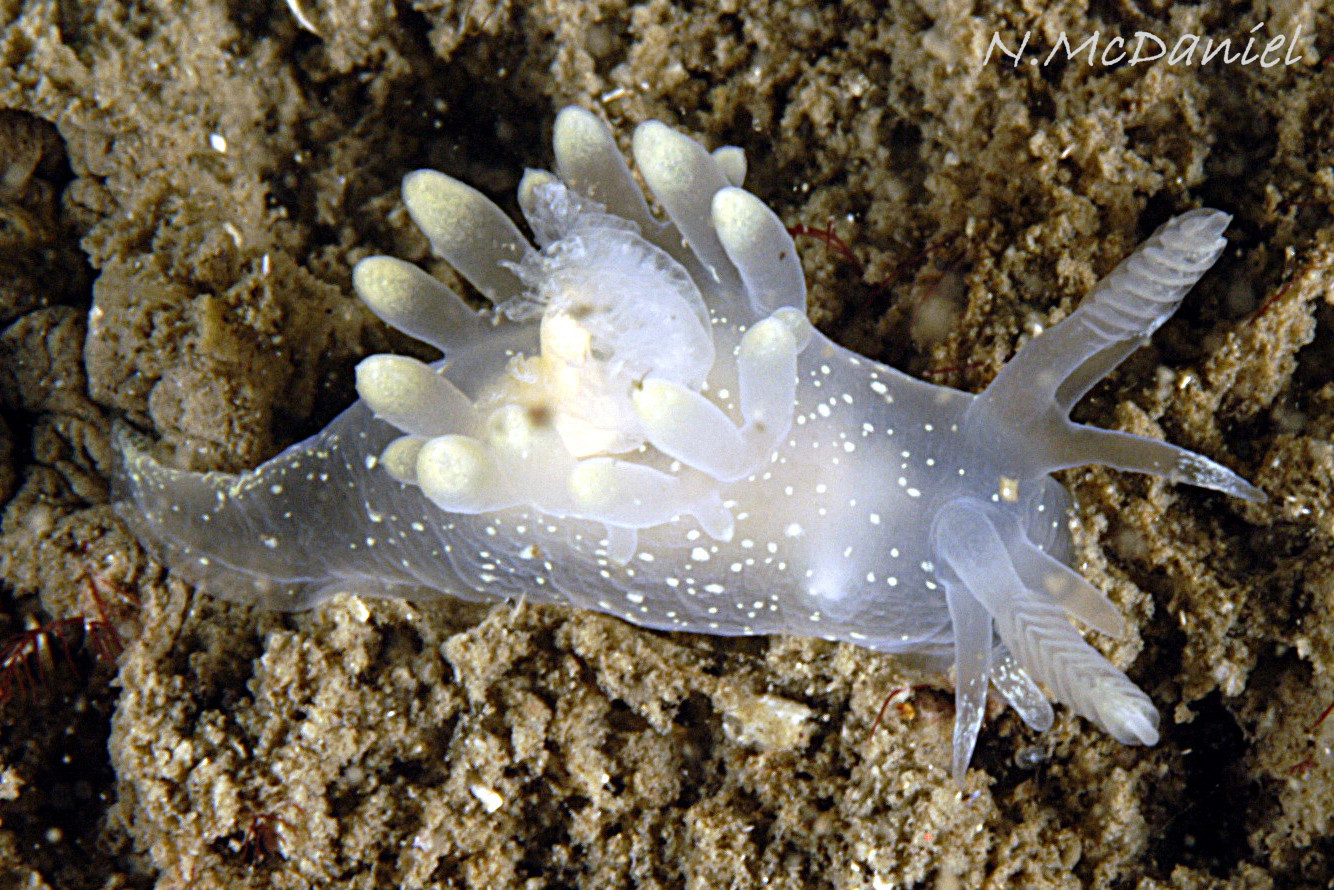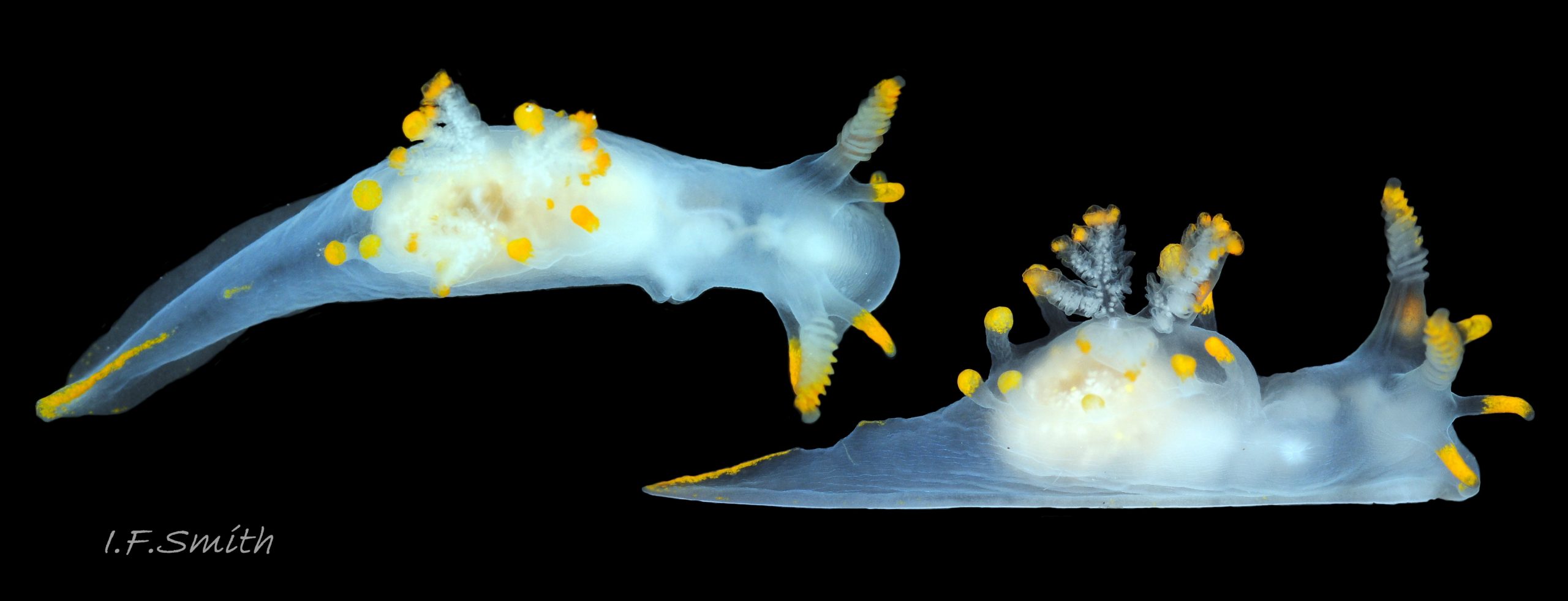Click image to enlarge with full caption. Main text below slider.
Ancula gibbosa (Risso, 1818)
PDF available at: www.researchgate.net/publication/358021760_Ancula_gibbosa…
Current taxonomy: World Register of Marine Species www.marinespecies.org/aphia.php?p=taxdetails&id=140029
Synonyms: Tritonia gibbosa Risso, 1818; Polycera cristata Alder, 1841; Ancula cristata (Alder, 1841);
GLOSSARY BELOW
Description (of European Form A)
In Britain, adults of this small species are usually about 13 mm long (Alder and Hancock, 1845 -55) 01 Ancula gibbosa and many finds are much smaller. Claims of up to 33 mm length probably relate to A. pacifica MacFarland, 1905, which was synonymised with A. gibbosa by Thompson and Brown (1984). The body is smooth, translucent white and sometimes reveals pinkish, brownish and opaque white viscera 02 Ancula gibbosa and 10 Ancula gibbosa . On the slender, tapering tail, there is a yellow or orange, medial, dorsal ridge which extends part or all the way to the gills 03 Ancula gibbosa . The mantle edge is indiscernible apart from a raised rim bearing up to seven elongate, distally slightly-swollen, yellow- or orange-tipped, pallial processes at either side of the gills 04 Ancula gibbosa . Three tripinnate, white gills, with yellow or orange tips and opaque white spheroids in the translucent stems and branches, are arranged around the white anal papilla 05 Ancula gibbosa ; one at the anterior and one at either side 06 Ancula gibbosa . The yellow or orange pigment is sometimes absent from some or all of the features above 07 Ancula gibbosa .
The rhinophores have up to twelve prominent, translucent white lamellae which are widely divided on the anterior and have yellow or orange pigment distally 08 Ancula gibbosa . The blunt apex protruding above the lamellae is often tilted forwards. The translucent, swollen, smooth base has two forward-pointing, long, linear, finely tapered, white pallial processes which are usually yellow or orange distally. The yellow or orange pigment is sometimes absent from the rhinophores and pallial processes.
The head consists of the mouth, its surrounds and a pair of small, white oral tentacles 09 Ancula gibbosa which may have yellow or orange tips. There are no linear processes on the anterior edge of the head, but the forward-pointing pallial processes at the base of the rhinophores are often mistaken for them in dorsal view 03 Ancula gibbosa . The long, narrow, white foot tapers evenly in its posterior half to a fine posterior point. It has no propodial tentacles 09 Ancula gibbosa . Its translucency and that of the upper body may reveal several internal organs 10 Ancula gibbosa . In dorsal view, only small parts of the foot protrude into sight 03 Ancula gibbosa .
Key identification features*
A. gibbosa 02 Ancula gibbosa
1) Two forward-pointing, not strongly-curved, linear processes at base of each rhinophore.
2) Several erect linear processes by each side of the gills.
3) Anterior of foot has no propodial tentacles 09 Ancula gibbosa .
4) No linear processes on the anterior edge of the head.
5) Orange or yellow pigment, when present, confined to distal part of appendages and a medial line to the rear of the gills.
6) Adults usually reach about 13 mm length.
*These features relate to the form of A. gibbosa sensu lato found in Europe. For American and Asiatic forms see ‘Discussion of distribution and status’ below.
Similar species
Ancula pacifica MacFarland, 1905, 11 Ancula gibbosa.
A. pacifica occurs on the Pacific coast of the USA and possibly in Japan. Image labelled ‘A. gibbosa’ [sensu lato] at en.seaslug.world/species/ancula_gibbosa (Baba, 1990 and Nakano, 2018).
All forms are regarded as a synonym of A. gibbosa by Thompson and Brown (1984) and on WoRMS (accessed 23 December, 2021) but Atlantic A. gibbosa collected by J. Goddard from Maine, USA were found by Harris (2011) to be genetically distinct from Pacific A. pacifica in the collections at the California Academy of Sciences (J. Goddard, pers. comm. 22 December 2021, via T. Gosliner).
1 to 4) Features as A. gibbosa.
5) Orange pigment on distal part of appendages, a dorsal line from between the rhinophores to the tip of the tail interrupted by the gills, and a dorso-lateral line from each rhinophore to under the linear processes by the gills and a short distance beyond the posterior process (MacFarland, 1905). Sometimes the lines are broken or fragmentary.
6) “the largest specimen yet taken measured 29 mm in length” (MacFarland, 1966).
7) CO1 sequences of Californian A. pacifica differ by over 10% from those of Atlantic A. gibbosa in Europe and eastern America (BOLD).
Trapania pallida Kress, 1968 12 Ancula gibbosa, T. tartantella (Ihering, 1886) 13 Ancula gibbosa
1) Single, elongate process curves backwards from the base of each rhinophore.
2) Single, elongate process curves backwards at each side of the gills.
3) Anterior of foot has distinct protruding propodial tentacles.
4) No linear processes on the anterior edge of the head.
5) Orange or yellow pigment conspicuous on body of T. tarantella and T. maculata; absent from T. pallida.
Polycera quadrilineata (O. F. Müller, 1776) 14 Ancula gibbosa and P. faeroensis Lemche, 1929.
1) No elongate processes at base of rhinophore.
2) Single, not strongly-curved, backward-pointing, linear process at each side of the gills.
3) Anterior of foot expanded into unobtrusive, small, propodial tentacles.
4) Four or more linear processes on the anterior edge of the mantle over the head.
5) Orange or yellow lines and marks frequent on body of P. quadrilineata, but usually confined to appendages, a dorsal line posterior of the gills and, occasionally, thin lateral lines on P. faeroensis.
Habits and ecology
A. gibbosa lives on the lower shore and sublittorally to about 100 m. Formerly, it was thought to feed on compound ascidians (Thompson & Brown, 1984), but this was because it was found feeding on small, overlooked Entoprocta growing epizoically on the ascidians. It is also found on Entoprocta living on other sessile organisms 15 Ancula gibbosa and inanimate objects, even in unpromising habitats such as a sand bag embedded in sand in the Mersey Estuary 16 Ancula gibbosa .
Like other nudibranchs, A. gibbosa is a simultaneous hermaphrodite. It deposits an irregularly curved ribbon of spawn which sometime forms loops. It may be wrapped around sessile organisms or attached by its edge to hard surfaces. Spawn masses have been recorded in most months in Britain 17 Ancula gibbosa . Shelled veliger larvae hatch from the spawn and live in the plankton before transforming into adult form.
Discussion of distribution and status
There is uncertainty about the limits of distribution because a complex of imperfectly understood species is reported from the Atlantic and Pacific in literature and recording schemes as Ancula gibbosa (Risso, 1818) sensu lato. GBIF map www.gbif.org/species/2291976 . The following forms are based on morphological features visible in images, some molecular sequencing and geographical locations 22 Ancula gibbosa . Further sequencing will probably necessitate re-evaluation of the situation. If you are able and willing to supply specimens in 95% ethanol alcohol of Ancula specimens from anywhere in the world to assist molecular research please contact Dr Marta Pola at marta.pola@uam.es
Form A
Form A has a translucent white body with orange or yellow pigment restricted to the tips of appendages and a dorsal line to the rear of the gills 03 Ancula gibbosa . Some or all of the orange/yellow may be missing 07 Ancula gibbosa ; the original description of the species by Risso (1818) seems to have been of an all-white specimen. Form A lacks any orange or yellow marks or lines on the main body in front of the gills.
This form is found on the coasts of Europe and, as the original description was made at Nice, should be accepted as Ancula gibbosa (Risso, 1818) sensu stricto. There are many records with photographs of it from Brittany northwards to the Arctic, except for the inner Baltic and parts of the southern North Sea. In Britain it is widespread but usually found in small numbers, perhaps owing to its small size and small, cryptic prey. U.K. distribution map, NBN species.nbnatlas.org/species/NBNSYS0000173816 .
In contrast, there are remarkably few records with images from further south than Brittany. Of over 200 images on Flickr www.flickr.com/search/?q=Ancula%20gibbosa (accessed 19 January 2022) not one was further south in Europe than Brittany. The image in a Galicia mollusc guide (Trigo et al., 2018) is of an Irish specimen, but there are online photographs from Galicia at www.asturnatura.com/fotografia/submarina-fotosub/ancula-g… . The only photographs I have found of a Mediterranean specimen are from the wreck of the Paguro drilling platform at about 20 m depth, 22 km offshore from Ravenna in the northern Adriatic 18 Ancula gibbosa. A large group of divers and shore workers who search for nudibranchs in Catalonia have found no A. gibbosa. The only record, without supporting image, in their area was a find on ascidians fouling a ship at Barcelona (Arias & Morales, 1963). It is possible that it was an alien stowaway or misidentification (M. Pontes, pers. comm. 5 January 2022). The only other published record of A. gibbosa in the Mediterranean traced by M. Pontes was of an apparently all-white specimen by Risso (1818) at the port of Nice where it appears that no further records of the species with images have been made in the two centuries since. An English translation of Risso’s imperfect description is provided in an appendix to this account. Another possible explanation for the scarcity of southern records is that A. gibbosa lives in the cooler water at greater depths beyond most diver activity in the Mediterranean and Portuguese Atlantic. Though the available southern specimens look like the northern ones, there remains the possibility that molecular sequencing might show genetic differences between them. If this proves the case, the northern specimens would probably revert to Ancula cristata (Alder, 1841) which was further described and illustrated in complete, precise detail in Alder and Hancock (1845-1855). That name was in general use until Thompson and Brown (1984) combined it with Ancula gibbosa (Risso, 1818).
Form B
Form B occurs on the Atlantic coast of North America from the St Lawrence Estuary to Maine or possibly Connecticut 22 Ancula gibbosa . Seven of the eight images of it on iNaturalist (accessed January 2022) are all-white specimens 19 Ancula gibbosa resembling all-white specimens of form A; only one had yellow on the tips of some appendages and none had the orange or yellow dorsal line to the rear of the gills found on most of form A. The single publicly available sequence of an A. gibbosa from eastern North America in GenBank (KP340388) has a CO1 gene difference of 3.25% from European specimens in both GenBank and the Barcode of Life Database (BOLD), raising the possibility of it being considered as a species distinct from A. gibbosa sensu stricto (K. Fletcher, pers. comm. 28 December 2021).
Form C
Form C is known on the Pacific coast of North America, mainly British Columbia, Canada but extending from the southern tip of Alaska (Millen, 1989) southwards to the north of California (Bairstow, 2019) 22 Ancula gibbosa . Sixteen of twenty images of it on iNaturalist (accessed January 2022) had small amounts of orange or yellow pigment on some appendages 20 Ancula gibbosa , four were completely white and none had the orange or yellow dorsal line to the rear of the gills found on most of form A. Apart from the greater prevalence in the sample of orange or yellow tips on appendages it is very similar to form B in the Atlantic coast of North America. Clarification with molecular sequencing of the relationship between it and forms A and B is needed.
Form D
Form D is translucent white with plentiful opaque white spots, and white or yellowish white pigment on appendages. There is a clear photograph of it from Vancouver where it was found locally abundant on a muddy substrate 21 Ancula gibbosa but it seems much rarer elsewhere than form C. Its extent beyond Vancouver is unknown, but two spotted-specimens regarded as A. gibbosa are described and illustrated from the Russian Far East in Chichvarkhin (2016, fig 3G) 22 Ancula gibbosa . Currently, there are no public molecular sequences of spotted A. gibbosa from the eastern or western Pacific (J. Goddard, pers. comm. 27 December 2021, via K. Fletcher).
Form E
Form E is the Ancula pacifica of MacFarland (1905). It occurs on the Pacific coast of California and, sometimes in years of warm El Niño events such as 2015, Oregon and Washington, overlapping the southern limit of form C (Goddard, 1984; K. Fletcher and J. Goddard, pers. comm. 28 December 2021). It is easily distinguished from all the other forms by three orange lines, a dorsal and dorso-laterals, on the body in front of the gills 11 Ancula gibbosa. The lines are sometimes fragmented. There is over 10% difference between CO1 sequences of Californian A. pacifica and forms A and B in the Atlantic. See ‘Similar species’ above for more detail.
Line drawings of Japanese specimens in Baba (1990) resemble Californian Ancula pacifica with fragmentary three lines in front of the gills, and the text states, “my specimens are almost exactly the same as Ancula pacifica MacFarland, 1905 (s.s.) in the external body form, the dorsal color pattern and the internal structures such as the radular teeth and penial hooks.” Twelve photographs of Japanese specimens at en.seaslug.world/species/ancula_gibbosa/9002 (accessed January 2020) resemble the drawings in Baba (1990).
Californian Ancula pacifica MacFarland, 1905 is clearly a valid species, but molecular sequencing is required to ascertain its relationship with northern Pacific forms C and D and Japanese form E.
Appendix
Original description of Ancula gibbosa (Risso, 1818) as Tritonia gibbosa Risso, 1818 from Nice, France .
Latin
“T. bossue. T. gibbosa, N.
T. corpore albo, lutescente, dorso gibbosa; branchiis lateralibus, in seriebus sex dispositis, N.”
French
“Corps renflé, oblong, pointu postérieurement, d’un blanc jaunàtre, bombé en dessus, avec un espѐce de bosse denticulée au milieu du dos. Còtés latéraux garnis de six rangées de touffes de tubercules durs, irréguliers. Expansion membraneuse du dessous de la bouche arrondie. Tentacules blancs, leur tube divisé au sommet en trois languettes simples. Pied étroit , canaliculé blanchàtre pointillé de brun.
Long., 0012-0014; larg. 003-004. Appar. mars, avril. Séjour parmi les coralines.”
English translation
“T. hunchback. T. gibbosa“, N.
“T. body yellowish white, humped on the back; lateral gills, arranged in rows of six“ , N.
“Body swollen, oblong, pointed posteriorly, of a yellowish white, domed above, with a kind of denticulate bump in the middle of the back. Lateral sides furnished with six rows of tufts of hard, irregular tubercles. Membranous expansion of the underside of the mouth rounded. White tentacles, their tube divided at the top into three simple strips. Foot narrow, canaliculate whitish dotted with brown. Length 27-31.6 mm; width 6.8-9 mm. Appears in March April. Lives among Corallina.”
Parts of this description are difficult to understand and/or relate to body features of A. gibbosa. The translation was checked by French malacologists, who wrote “We have to admit that we also have difficulties with the description by Risso when looking at our photos. Even being native French speakers, we have problems understanding what he describes.” The description omits the diagnostic pair of processes at the base of each rhinophore, says the foot is dotted with brown, and seems to describe rhinophoral sheaths, making questionable the identity of what he described and the assumption that it is conspecific with Ancula cristata (Alder, 1841).
Acknowledgements
For use of images, I gratefully thank Jørn Ari, David Fenwick www.aphotomarine.com , Jeff Goddard, Filippo Ioni www.facebook.com/filippo.subegoist/ , Paula Lightfoot, Neil McDaniel, Poul E. Rasmussen and Sara Thiebaud. I thank Paul Brazier and Lucy Kay for specimens to photograph, and Marta Pola and Florence & Marc Cochu nature22.com/ for information. I am greatly indebted to Karin Fletcher and Jeff Goddard for detailed information and advice about anatomy and Atlantic and Pacific species in North America. I am grateful to Miquel Pontes opistobranquis.info/en/ for most useful information and literature about the status of A. gibbosa in Iberia and the Mediterranean.
References & links
Alder J. 1841. Observations on the genus Polycera with descriptions of two new British species. Annals and Magazine of Natural History6: 337-342, pl. 9
www.biodiversitylibrary.org/item/19590#page/376/mode/1up (As Polycera cristata on p. 340 and on plate X [error in text says IX] figs. 10, 11 and 12 at www.biodiversitylibrary.org/item/19590#page/372/mode/1up )
Alder, J. & Hancock, A. 1845-1855. A monograph of the British nudibranchiate mollusca. London, Ray Society. Family 1 pl. 25 www.biodiversitylibrary.org/item/131598#page/218/mode/1up
Ancula gibbosa iNaturalist (Map tab) (Accessed 16 January 2022) www.inaturalist.org/taxa/47138-Ancula-gibbosa
Ancula gibbosa Seaslug World (accessed 17 January 2022)
en.seaslug.world/species/ancula_gibbosa
Arias, E. and Morales E. (1963). Ecología del Puerto de Barcelona y desarrollo de adherencias orgánicas sobre embarcaciones. Investigación Pesquera 24: 139-163.
digital.csic.es/bitstream/10261/189189/1/Arias_Morales_19…
Baba, K. 1990. Notes on the rare genera Trapania and Ancula from Japan with the description of a new species (Nudibranchia: Goniodorididae). Venus, Japanese Journal of Malacology 49(1): 8-18.
www.jstage.jst.go.jp/article/venusjjm/49/1/49_KJ000043436…
Bairstow, A. 2019. Humped Ancula sea slug (Ancula gibbosa). [Image of unlined Ancula cf. gibbosa in Humboldt County, California] www.inaturalist.org/observations/28086517
Ballesteros, M., Madrenas, E. and Pontes, M. Ancula gibbosa (Risso, 1818). OPK Opistobranquis . Accessed 4 January 2022. opistobranquis.info/en/guia/nudibranchia/doridina/doridoi…
Behrens D.W. 2004. Pacific coast nudibranchs, supplement II new species to the Pacific coast and new information on the oldies. Proc. Calif. Acad. Sci. 55 (2) : 11– 54.
researcharchive.calacademy.org/research/scipubs/pdfs/v55/…
Chichvarkhin, A. 2016. Shallow water sea slugs (Gastropoda: Heterobranchia) from the northwestern coast of the Sea of Japan, north of Peter the Great Bay, Russia. PeerJ 4:e2774 doi.org/10.7717/peerj.2774 (G )
Goddard, J.H.R. (1984) The opisthobranchs of Cape Arago, Oregon, with notes on their biology and a summary of benthic opisthobranchs known from Oregon. The Veliger 27(2):143–163 www.biodiversitylibrary.org/item/134487#page/159/mode/1up
Hallas, J.M., Chichvarkhin, A. and Gosliner, T.M. 2017. Aligning evidence: concerns regarding multiple sequence alignments in estimating the phylogeny of the Nudibranchia suborder Doridina. R. Soc. Open Sci. 4: 171095. doi.org/10.1098/rsos.171095
Harris J.K. 2011. A molecular phylogeny of Polyceridae (Nudibranchia) with comments on ‘Phanerobranchia’. Unpublished M.S. Thesis, San Francisco State University, San Francisco, California xi + 46 leaves; Major advisor: T. M. Gosliner, California Academy of Sciences. scholarworks.calstate.edu/concern/theses/1g05fh02k?locale=it
(Accessed 25 Dec 2021, but full thesis not seen. Sequence MF958422 of A. pacifica published in Hallas et al. 2017).
MacFarland, F. M. 1905. A preliminary account of the Dorididae of Monterey Bay, California. Proc. Biol. Soc. Wash. 18: 35-54.
www.biodiversitylibrary.org/page/3336883#page/69/mode/1up
MacFarland, F. M. 1966. Studies of opisthobranchiate mollusks of the Pacific coast of North America. Proc. Calif. Acad. Sci. 6: 1-546, pls. 1-72.
Millen, S.V. 1989. Opisthobranch range extensions in Alaska with the first records of Cuthona viridis (Forbes, 1840) from the Pacific. The Veliger 32(1): 64–68. www.biodiversitylibrary.org/item/137792#page/76/mode/1up
Nakano, R. 2018. Field Guide to Sea Slugs and Nudibranchs of Japan. Tokyo, Japan, Bun-ichi Co. Ltd. 544pp. [in Japanese].
Paz-Sedano, S., Díaz Agras, G., Gosliner, T.M. and Pola, M. 2021.
Revealing morphological characteristics of Goniodorididae genera (Mollusca: Nudibranchia) Organisms Diversity & Evolution. Springer.
link.springer.com/content/pdf/10.1007/s13127-021-00508-w.pdf
Risso, A. 1818. Mémoire sur quelques Gastropodes nouveaux, Nudibranches et Tectibranches observés dans la mer de Nice. J. Phys. Chim. Hist. Nat. 87: 368-377. See p. 371 www.biodiversitylibrary.org/item/29610#page/387/mode/1up
Rudman, W.B. Ancula gibbosa (Risso, 1818). Sea Slug Forum. www.seaslugforum.net/find/ancugibb (Accessed December 2021.)
Thompson, T.E. & Brown, G.H. 1984. Biology of opisthobranch molluscs 2. London, Ray Society.
Trigo, J.E.; Diaz Agras, G.J.; Garcia Alvarez, O.L.; Guerra, A.; Moreira, J.; Pérez, J.; Rolán, E.; Troncoso, J.S,; Urgorri, V.. 2018. Guia de los Moluscos Marinos de Galicia. Servicio de Publicacións da Universidade de Vigo.
Current taxonomy: World Register of Marine Species www.marinespecies.org/aphia.php?p=taxdetails&id=140029
Glossary
BOLD = Barcode of Life Database www.barcodinglife.org
buccal mass = organ system just inside the mouth that includes the odontophore, radula, and a complex of muscles to operate them. In some nudibranchs, including species of Ancula, this mass also includes a round, muscular buccal pump enabling suctorial ingestion of food.
circum-oesophageal nerve ring = ganglia-bearing nerve cord which encircles the oesophagus.
digestive gland = large organ in gastropods which acts like the liver and pancreas in mammals to absorb food.
distal = away from centre of body or from point of attachment.
Entoprocta = (a.k.a. Kamptozoa) a phylum of small, <7 mm, goblet-shaped, sessile animals. See www.seaslugforum.net/find/kamptozoa
epizoic = growing or living on the exterior of a living animal.
ganglia = (sing. ganglion) swellings of the nervous system composed of clusters of nerve cells linked by synapses; they help process sensory stimuli and control organs.
hermaphrodite, simultaneous = individual acts as both male and female at the same time with similar partner(s).
lamellae = (sing. lamella) gill leaflets or small plates on rhinophores on nudibranchs.
mantle = (of nudibranchs) sheet of tissue forming part or all of notum (dorsal body surface).
oesophagus = tube from mouth to stomach.
ovotestis = (pl. ovotestes) hermaphrodite organ serving as both ovary and testis.
pallial = (adj.) of, relating to, or produced by the mantle (pallium).
papilla = (pl. papillae) small, nipplelike, sensory protruberance.
plankton = animals and plants that drift in pelagic zone (main body of water).
propodial = at the front of the foot.
radula = chitinous ribbon of teeth; extended on odontophore to acquire food.
sensu lato = (abbreviation s.l.) in the wide sense, possibly an aggregate of more than one species.
sessile = (adj.) of immobile animals living attached to substrate or other organisms.
tripinnate = (of gill plume) threefold branching; “trunk, boughs, branches”.
veliger = shelled larva of marine gastropod or bivalve mollusc which moves by action of cilia on a velum (bilobed flap). Stage may be passed in plankton or within liquid-filled egg-capsule.
WoRMS = World Register of Marine Species
